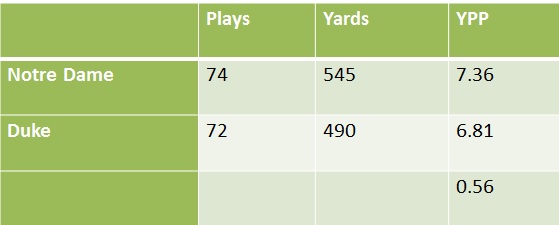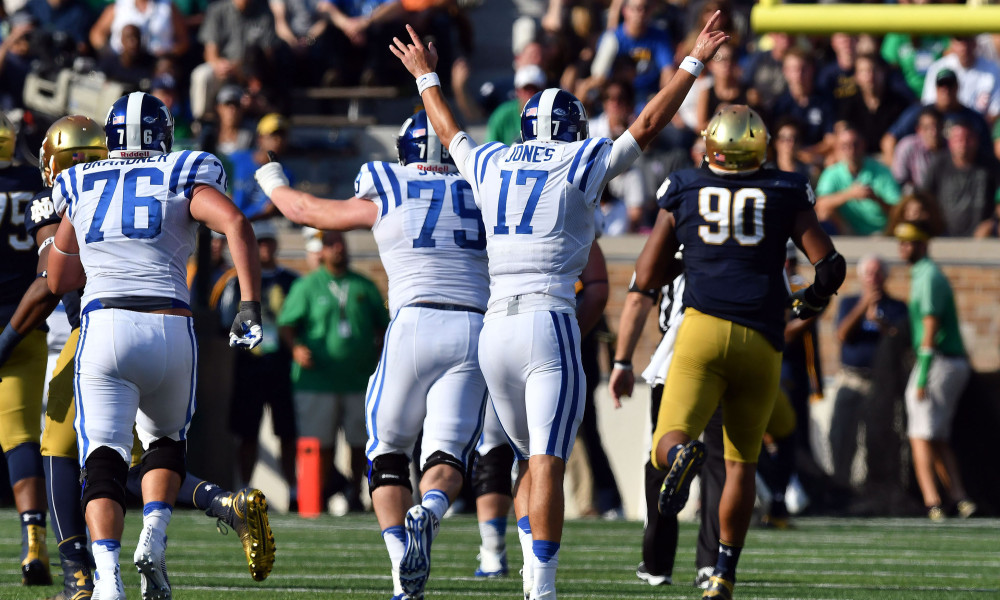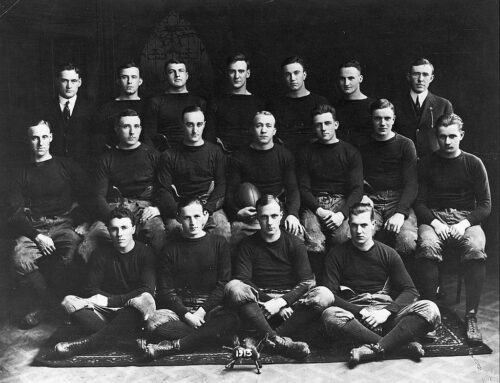Notre Dame’s loss to Duke reviewed using the Five Factors that lead to success in football. If making decisions about coordinators was a factor, at least the Irish would have won that one.
Confused? Check out the advanced-stats glossary here.
A giant step backwards
The 2015 season was promising for a lot of reasons, but maybe topping the list was that even with tons of injuries at key positions, the team avoided losses to bad teams. The Irish lost close road games to two top five teams, then suffered a bigger loss (but avoided a total shellacking) to another top-5 team in the bowl game.
It felt like a potential inflection point – that Brian Kelly’s vision for the ND program was now fully operational in Year 6, and could sustain some of the losses – whether injury, academic, or otherwise – that had doomed past editions. As with any programs there will always be ebbs and flows, but to consistently beat the Pitt, Navy, and Boston College’s of the world, even if it was ugly, would be a clear departure from the DavWillingWeis era.
And now 2016 has happened, and we’re right back there again. As someone who lived through the failure (and covered the team) of the ’09 season, this was a story line that was far too familiar. A superior offensive unit loaded with NFL-caliber talent has no room for error and makes too many mistakes. A defensive unit is in turmoil. The visitors walk into Notre Dame Stadium looking like the aggressors, so much more confident and well-prepared, and walk out with a lasting memory of the time they beat a storied program in their own house.
Explosiveness

Simply from a results perspective, Brian Van Gorder’s defenses never excelled at the things they were supposed to. An initially aggressive scheme didn’t reap any of the benefits, like sacks and turnovers, that aggression is intended to cultivate. And the defense then painfully felt all of the risks of aggression realized, letting up explosive play after explosive play. Moves towards conservatism in recent weeks (perhaps out of desperation or realization that relying on executional improvement wasn’t coming) only brought variety to the ways the defense failed – some “bend, then break” to go with the big plays yielded.
The most successful year of the BVG era was in 2015, when if you put the most optimistic spin possible on it, the defense was … above average at limiting efficiency and forcing three and outs? Even last season the defense showed the same disheartening trademarks that led to Van Gorder’s firing – struggles against the run, poor tackling and communication, and of course the aforementioned explosive plays.

And while this was a long-needed move, it won’t solve a whole host of issues plaguing this team. Poor fundamentals and a lack of development won’t change with new play-calling, and shifts in scheme will be minor. True freshman will still be playing key roles at multiple positions, and I don’t expect this shuffle to suddenly inject a ton of fire into players that have shown a lack of consistency with focus and efforts their whole careers.
It is going to be a gruesome slog the rest of the way, but it maybe this allows this team to play more loose and free – they have nothing to lose, the perception of the world against them, and the opportunity to play spoilers and re-gain some pride against the likes of Stanford, Miami, Virginia Tech, and USC.
Efficiency

The offense had an uneven performance, and it’s hard to pinpoint exactly what needs to take place for it to take the next step to get from “good and inconsistent” to “very good and consistent with the possibility of greatness”.
The offensive line, both in pass protection and run blocking, hasn’t lived up to its potential, but has been fine. The quarterbacking, while lately struggling through occasional bouts of inaccuracy and poor decisions, is fine, although maybe some of the NFL draft hype was a bit premature. The wide receivers are exciting but still working on reliability and playing smarter (avoiding fumbles), and are fine. The running backs seem fine.

Everything is kind of fine yet nothing is fine, because the offense is making errors that there is simply no room for with this defense. After the Texas game I wrote that every single possession for the offense is exceedingly meaningful because of the ineptitude on defense, and I think the offense has been feeling that pressure to be perfect.
Kizer even said it himself last week after the Michigan State loss – “We can go out there and score every drive and put up 70 points, and I truly believe in that. And we fell short of that, and that has a lot to do with me.”
Field Position
Average Starting Field Position
Notre Dame: Irish 25
Duke: Blue Devils 32
Special teams again had a poor day, yielding a kickoff return for a touchdown that put Duke back in the game after the Irish had jumped out to a 14-0 lead at home. Justin Yoon missed his only field goal attempt, and seems to be off to a slow start again.
S&P+, which just began rating special teams this year, has Notre Dame ranked 103rd nationally in the category, primarily due to the early kicking game issues. Last weekend the defense also didn’t help out much with starting field position – even when keeping the Blue Devils scoreless for a stretch in the second half, they still were yielding yards and field position.
Finishing Scoring Opportunities

Turnovers
The Irish lost the turnover battle 3-1, and were fortunate it wasn’t worse – Kevin Stepherson and Josh Adams both lost the ball but recovered their own fumbles. If you’re looking for big picture issues, turnovers have been a constant – the Irish haven’t had a positive turnover margin since 2012, and are now at a margin of -0.75/game.
A couple bright spots and more clouds:
Depressed? Here’s a few reasons for optimism for the rest of the season:
- Through four games, the offense and defense have flipped the script in an area they’ve struggled over the last four years- power run situations. On 3rd/4th and short (less than two yards), the offense has converted 90.9% of runs (4th) while the defense has held opponents to 57.9% (30th).
- On a similar note, after all the hand-wringing about the red-zone offense last season, the Irish offense has been very good in that area and converting scoring opportunities into points. 80% of red zone visits have been converted to touchdowns, and the ND offense is 8th nationally finishing scoring opportunities (points per trip inside the 40). The Irish offense has been very good, and if they can minimize drive-killing turnovers, they should give the team a fighting chance no matter what happens defensively.
- Lack of depth forcing young players to play significant roles before they’re ready hurts in the moment, but should become positive experience down the road for players like Devin Studstill, Donte Vaughn, Julian Love, and Jalen Elliott. They’ll struggle and make freshmen mistakes, but also grow and start making more and more of the plays where they flashed on Saturday.
Ok, now a few more reasons your depression is justified (because you totally needed more):
- While there have been some bad snaps by opponents that have put the ball on the ground, Notre Dame doesn’t have credit for a single forced fumble in four games.
- Notre Dame’s advanced stat profile shows a defense that maybe is doing some other things well – only 41st in defensive explosiveness! 10th in opponent rushing explosiveness! But this is actually a really sad red herring.
- Because the Irish have given up so many successful plays (113th in defensive efficiency), mostly of the shorter variety, the long gains haven’t hurt the average “points” per successful play given up as much as it should for a team with a decent defense. So there’s that.





More beating a dead horse… I saw somewhere that the 2016 defense has given up more plays of 60+ yards than Diaco’s defenses did across his four years at Notre Dame – COMBINED. Ouch.
Let’s hope the new leaf we’re turning over is another chapter, and not just another page of the same old story.
That’s horrifying. Sounds like we missed our window on a gameday t-shirt.
Front: South Bend but Don’t Break
Back: We Miss you DIIaco! Fire Van Gorder!